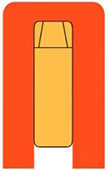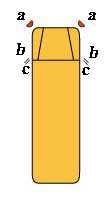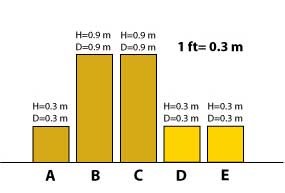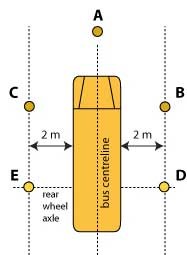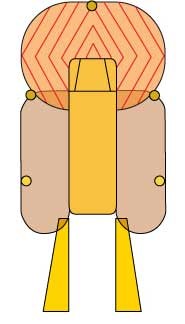School buses are the safest way to transport children to and from school.
The federal government updated rules for school bus mirrors in 1998 to enhance the field-of-view around buses. Proper use of mirrors reduces blind spots for school bus drivers, keeping children safer. Before driving, you must adjust the bus's mirrors.
Always take the time to actually LOOK at the reflected image in the mirror and to SEE what is there.
On this page
- The danger zone for blind spots
- Mirrors required on school buses
- Cylinders for testing mirrors
- How to adjust your mirrors
- A Better View: School Bus Mirror Adjustment Procedures
- Contact us
The danger zone for blind spots
Blind spots are areas where you can't see without the help of mirrors. The combined blind spots surrounding the bus are called "the danger zone."
Text description
Illustration of a school bus with a large orange zone along the sides and in the front marking the "Danger zone": an area of blind spots around a school bus where you can't see without the help of mirrors.
Mirrors required on school buses
The safety standard for school bus mirrors requires 3 sets of mirrors:
- the cross-over (or cross-view) mirrors (a)
- the side convex mirrors (b)
- the side flat mirrors (c)
School bus drivers must know how to adjust these systems of mirrors so that they work properly, providing a continuous and complete field of view.
The combination of these mirrors is also referred to as System A and B mirrors:
- System A includes the side flat and side convex mirrors
- System B includes the cross-over (or cross-view) mirrors
Text description
Illustration of a school bus with:
- 2 front corners labelled “a”
- 2 sides near the front labelled “b”
- 2 sides a bit behind b labelled “c”
Cylinders for testing mirrors
To test your field of view, you need 5 cylinders. You may use any object of similar sizes to replace the cylinders, such as traffic cones or garbage pails.
Text description
Graph of 5 cylinders, of different heights, which are labelled A,B,C,D,E. A note above the graph says, “1 ft=0.3 m”
- A is labelled H=0.3 m D=0.3 m
- B is labelled H=0.9 m D=0.9 m
- C is labelled H=0.9 m D=0.9 m
- D is labelled H=0.3 m D=0.3 m
- E is labelled H=0.3 m D=0.3 m
How to adjust your mirrors
When adjusting your mirrors, sit in your normal driving position, with your seat properly adjusted and your seat belt buckled.
Placing the cylinders
- Place cylinder A in front of the bus so that its top is directly visible at the driver's eye position
- Place cylinders D and E 2 metres outward from the side of the bus along the centreline of the bus rear-wheel axle
- Place cylinders B and C 2 metres outward aligned with the front bumper, and reposition them rearward, as shown in the diagram, when the side convex mirror is adjusted
Text description
Overhead illustration of school bus with:
- A point labelled "A" that's a bit ahead of the front of the bus
- A dotted vertical line that runs down the length of the bus and reaches almost to Point A. The text by the line says "bus centerline."
- Points B and D parallel to each other on the right side of the bus, with a horizontal arrow to the bus showing that the points are "2 m" from the side of the bus
- Points C and E on the left side with a horizontal arrow to the bus showing that the points are "2 m" from the side of the bus
- A horizontal line from point E to the bus, stating "rear wheel axle"
Adjusting the cross- over mirror on driver's side and side convex mirror
- Adjust the cross-over mirror so you can see the front bumper and all of cylinder A on the right side of the reflecting surface, with the horizon kept to a minimum
- For the curbside cross-over mirror, cylinder A is on the left
- Adjust the side convex mirror horizontally so that the side of the bus is barely visible on the right side of the reflecting surface
- For the curbside side convex mirror, the bus is visible on the left
- Adjust vertically (tilt up and down) to get the best view towards the side of the bus
- Cylinder E should be entirely visible and the horizon should not be visible
- For the curbside side convex mirror, cylinder D should be visible
- Move cylinder C rearward along a 2-metre distance parallel to the side of the bus until it's entirely visible in the side convex mirror
- For the curbside side convex mirror, use cylinder B
- If needed, re-adjust the cross-over mirrors to ensure that cylinder C is visible
- For the curbside cross-over mirror, use cylinder B
Field of view using the school bus mirrors
Text description
Illustration of a bus with 4 zones drawn around it:
- A wide oval area in front of the bus, and by its front sides.
- 2 side zones that overlap a bit with the front zone
- 2 narrow zones in light yellow extending behind the bus, to the left and right sides
Adjusting the side flat mirror on driver's side
- Adjust the side flat mirror so that the side of the bus is barely visible on the right side of the reflecting surface
- For the curbside side flat mirror, the bus is on the left
- Adjust vertically (tilt up and down) to improve the field of view to the side of the bus and to minimize the horizon
A Better View: School Bus Mirror Adjustment Procedures
To see how a driver adjusts mirrors, watch this training video first issued in 1998.
A Better View: School Bus Mirror Adjustment Procedures
(PDF, 1.3 MB)
Contact us
Telephone: 1-800-333-0371 (toll-free), 613-998-8616 (Ottawa-Gatineau region)
Email: mvs-sa@tc.gc.ca
